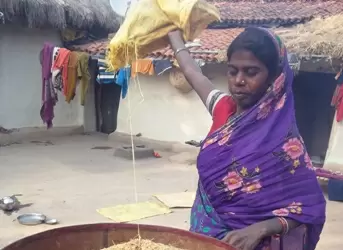Local farmers’ clubs are taking innovation to the doorsteps to make life easier

03-November-2014
Vol 5 | Issue 44
Parvati Devi, 45, of Madanpur village in Deoghar district, Jharkhand, is a happy woman these days and the reason for her smiles is a newly-acquired rice par boiler unit, which has allowed her to save more than 50 per cent of her yield that used to get destroyed when she’d heat the paddy to make par-boiled rice, popularly known as ‘usna’ in the region.
For this mother-of-eight growing paddy on their two-acre farm was not difficult as she had been tilling land ever since she was a young girl. However, the nightmare began when, at the end of every Rabi season, she had to prepare the par-boiled rice for storage.
 |
|
Many women like Rina Devi have benefited from the innovative rice boiler unit, which allows them to save more than 50 per cent of their yield when they heat the paddy to make par-boiled rice (Photo: Saadia Azim\WFS)
|
Across eastern India, ‘usna’ is an all-time favourite with rice eaters. Post-harvest the grain is steamed in an iron tray for one-and-a-half hour and then dried under shade. Thereafter, it is sent to the rice hulling machine for final processing.
The steaming process is labour intensive as the paddy requires constant monitoring and turning over by hand to prevent it from burning.
“Every year, I used to end up losing sizeable amounts of the yield as I used the age-old technique of boiling paddy to prepare par-boiled rice that we consume as part of our daily meal. While this rice is better to taste, healthy and lasts for a longer period of time, the boiling process is tiring and the losses incurred can be huge,” she remarks.
Like Parvati, other farmers in the area, too, had resigned themselves to losing a sizeable portion of their produce during processing. However, the introduction of the ingenious rice par-boiler unit has slowly improved the situation not just for the local women – it has lessened their work burden considerably – but also assured families of a steady supply of their favourite staple.
This innovative technology has been brought to people’s doorsteps through local farmers’ clubs constituted by the Centre for World Solidarity (CWS), a non government organisation in the area, which is implementing the Fight Hunger First Initiative (FHFI) with support from Welthungerhilfe, a German developmental agency.
Says Rajesh Kumar Jha from CWS, which worked with farmers to develop the unit, “The idea behind creating this device was to save rice that forms the basis of all food in these parts. The procedure of boiling the paddy consumed enormous amounts of fuel and needed dedicated manpower but ultimately the loss was still colossal.”
The unit called Devipur Usna has been designed by Abhivyakti Foundation, a non-government organisation working with CWS, and it uses convection heating to treat the rice.
A 200-litre drum that doubles up as storage is divided into two vertical chambers with the help of a net sieve fixed one foot from the bottom. The lower chamber is used to store water that is boiled to create steam that rises to cook the paddy uniformly. Just above the sieve there is an opening from where the steamed rice can be removed.
Around three years back, a trial run of the first unit was conducted in Madanpur village with the help of two farmers. Their feedback enabled some vital design modifications - an additional sheet was put at the bottom to safeguard the grain from high heat.
Elaborates Lokeshwar of Abhivyakti Foundation, “The minor changes we made to the paddy boiler unit have had a significant impact. It is economical at every level - just one person is needed to operate the boiler, is less time consuming and needs minimal fuel. Moreover, the paddy that used to get burnt earlier due to high heat is unaffected.”
The Devipur Usna has four fold benefits. A farmer can steam 1800 kilos of paddy in a single batch, only one person is required to keep an eye, there is no need to turn it over and all this results is a reduced work load for the womenfolk.
Within an hour and a half the entire process is complete. The fuel consumption is down by 50 per cent as is the probability of losing the produce. Currently, this unit is being put to use in 50 villages of Deoghar district’s three blocks.
As per the 61st round of National Sample Survey (NSS) 46.3 per cent of people in Jharkhand are living below poverty line while the per capita income is only Rs 7,200. The India State Hunger Index (2008), too, reveals a grim picture documenting the presence of severe undernourishment, child malnutrition and infant mortality.
“In light of these circumstances, all efforts made to provide food security assume great significance in the state. Thanks to this rice par boiler unit, at least farmers like me do not have a reason to complain and fret that the food we grew was lost,” says Rina Devi, who had lived with severe loss of grain year after year in her small village of Devipur until she discovered the goodness of the steaming unit.
Although storage of food grains and quality and quantity of produce still remain key concerns for several farmers in the region, they are pleased with the fact that at least the food they grow with great diligence and patience can be saved with a device that has proved to be quite the lifesaver.
“For women famers like me, this unit is a real boon. While the men-folk continue to migrate seasonally for work those of us left behind have remained loyal to the land and cultivation remains our main work. Small ways to keep the losses to a minimum can only be a bonus for us,” concludes Rina Devi. - Women's Feature Service
















